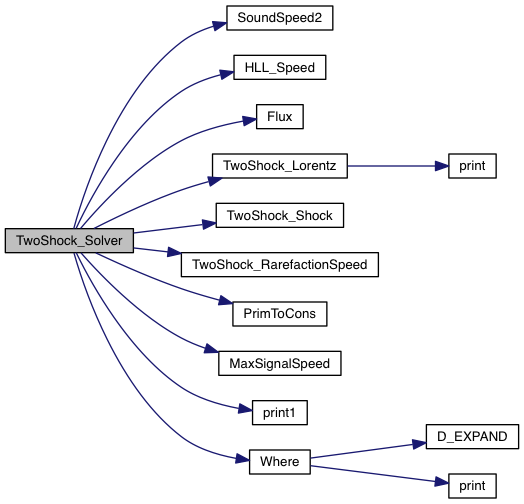|
PLUTO
|
|
PLUTO
|
Implementation of the two-shock Riemann solver for the relativistic hydro equations. More...
#include "pluto.h"
Go to the source code of this file.
Macros | |
| #define | MAX_ITER 20 |
| #define | small_p 1.e-12 |
| #define | small_rho 1.e-12 |
| #define | INTERPOLATE_RAREFACTION YES |
| #define | accuracy 1.e-6 |
Functions | |
| static double | TwoShock_Lorentz (double *U, int n) |
| static void | TwoShock_Shock (double, double, double, double, double, double, double, double *, double *, double *, int) |
| static double | TwoShock_RarefactionSpeed (double *u, int side) |
| void | TwoShock_Solver (const State_1D *state, int beg, int end, double *cmax, Grid *grid) |
| double | TwoShock_RarefactionSpeed (double w[], int iside) |
Variables | |
| static double | qglob_r [NFLX] |
| static double | qglob_l [NFLX] |
| static double | gmmr |
Implementation of the two-shock Riemann solver for the relativistic hydro equations.
Solve the Riemann problem for the relativistic hydrodynamics equations using the two-shock approach described by Mignone, Plewa and Bodo (2005). The formulation works with IDEAL or TAUB equation of state.
On input, this function takes left and right primitive state vectors state->vL and state->vR at zone edge i+1/2. On output, return flux and pressure vectors at the same interface i+1/2 (note that the i refers to i+1/2).
Also during this step, compute maximum wave propagation speed (cmax) for explicit time step computation.
Reference:
Definition in file two_shock.c.
| #define accuracy 1.e-6 |
Definition at line 35 of file two_shock.c.
| #define INTERPOLATE_RAREFACTION YES |
Definition at line 33 of file two_shock.c.
| #define MAX_ITER 20 |
Definition at line 30 of file two_shock.c.
| #define small_p 1.e-12 |
Definition at line 31 of file two_shock.c.
| #define small_rho 1.e-12 |
Definition at line 32 of file two_shock.c.
|
static |
Compute Lorentz gamma factor.
Definition at line 359 of file two_shock.c.


|
static |

| double TwoShock_RarefactionSpeed | ( | double | w[], |
| int | iside | ||
| ) |
Compute head or tail characteristic speeds enclosing the rarefaction fan:
| [in] | w | a vector of primitive quantities containing the three velocities. |
| [in] | iside(IN) | an integer specifying a left (-1) or right (+1) rarefaction wave. |
Definition at line 460 of file two_shock.c.

|
static |
Compute post shock quantities u1, dudp, zeta, for a given value of the post-shock pressure p1
Definition at line 387 of file two_shock.c.

Solve Riemann problem for the relativistic HD equations using the two-shock Riemann solver of Mignone et al. (2005).
| [in,out] | state | pointer to State_1D structure |
| [in] | beg | initial grid index |
| [out] | end | final grid index |
| [out] | cmax | 1D array of maximum characteristic speeds |
| [in] | grid | pointer to array of Grid structures. |
Definition at line 45 of file two_shock.c.

|
static |
Definition at line 42 of file two_shock.c.
|
static |
Definition at line 42 of file two_shock.c.
|
static |
Definition at line 42 of file two_shock.c.